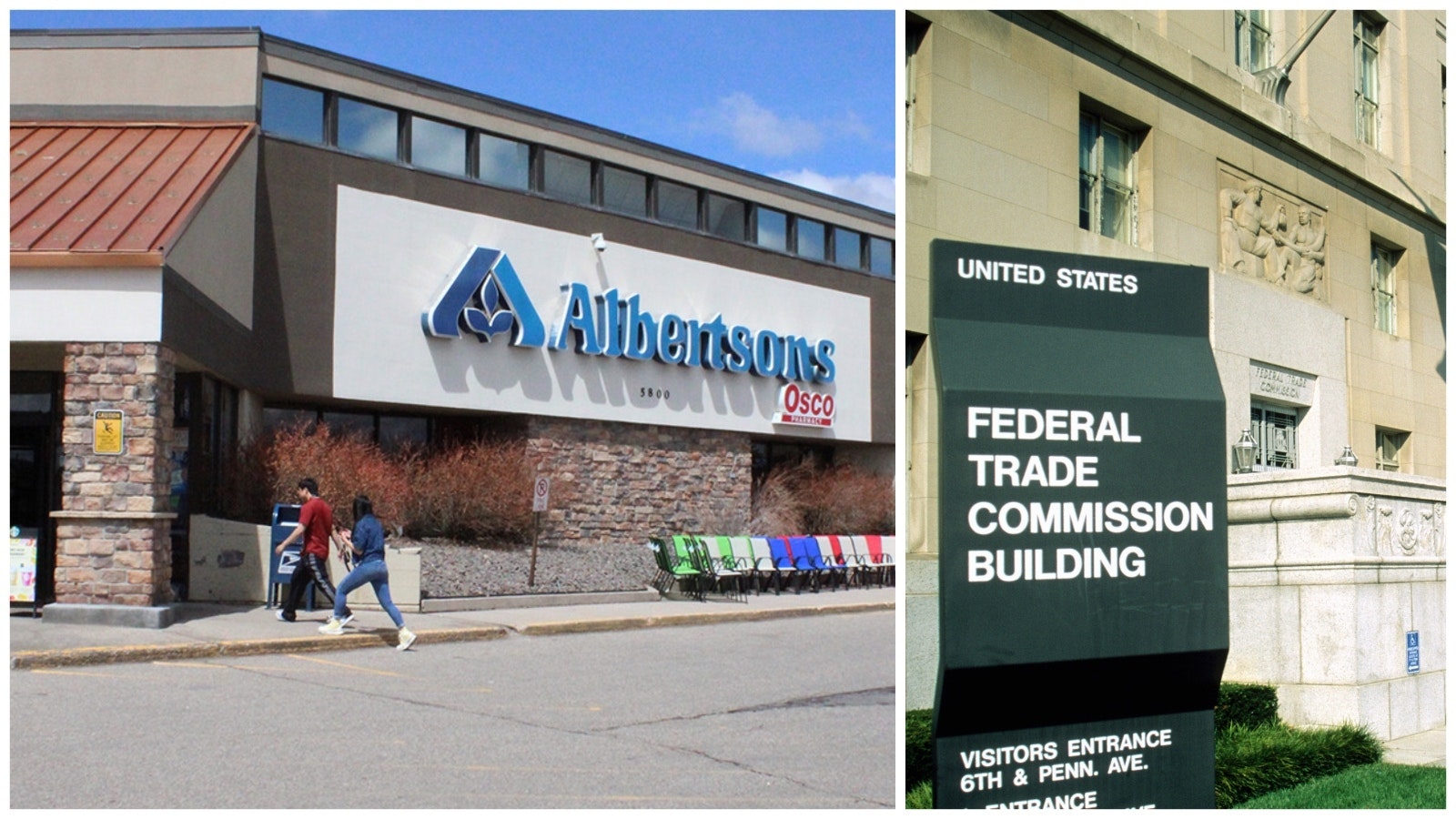Judges in two states issued injunctions Tuesday to block the proposed $25 billion merger between grocery giants Kroger and Albertsons.
The Federal Trade Commission is likely to prevail in its case against the $25 billion merger proposed between Kroger and Albertsons, an Oregon judge says, so he is issuing a preliminary injunction against the merger, pending the outcome of the federal trial.
Meanwhile, in Washington, a state judge has also issued an injunction to block the Albertsons-Kroger merger.
“In my view the evidence convincingly shows that the current competition between Kroger and Albertsons stores is fierce in the state of Washington,” Judge Marshall Ferguson said in his ruling. “By contrast the divestiture buyer, wholesaler C&S (Wholesale Grocers), with its limited retail experience and infrastructure, will not be able to replicate the ferocity of that competition or compete effectively in Washington against the colossus of a merged Kroger and Albertsons.”
The cases are two of three the companies face that seek to stop their merger. The third case has been filed in Colorado. The Oregon case, however, is the one brought by the Federal Trade Commission along with several other states, including Wyoming. The ruling there signals that the ballgame is the FTC’s to lose at this point, and suggests that the merger probably will ultimately be blocked.
UFCW Cheer
United Food and Commercial Workers unions, including Local 7, which represents about 750 Wyoming grocery store workers, said the rulings support what they’ve been saying all along about the merger.
“The judge got it right,” UFCW Local 7 President Kim Cordova told Cowboy State Daily. “We are relieved, and we applaud the recent decisions today by both of the courts, and we’re hoping that we hit the trifecta, and the Colorado judge rules in the same manner.”
Cordova said both judges’ statements in court and in their rulings addressed many of the concerns that Local 7 has been raising about how this will affect both consumers and grocery store workers.
“C & S (Wholesale Grocers) is not a viable competitor,” Cordova said. “They were not going to be able to compete and bring competition back to the market, which we were very concerned about. And also, Kroger and Albertsons’ empty promises to take care of workers and to lower prices — none of that would have been enforceable had the merger been approved.
“This would have been a disaster,” Cordova continued, “So I’m ecstatic about the court’s decision and happy for our retirees, our community, our shoppers, and most importantly, my membership, who were so worried about this merger.”
UFCW unions also called on Kroger and Albertsons executives to “abandon this misguided merger and turn their focus back to where it belongs: operating grocery stores.”
Redirecting the billions slated for the merger would help the stores reinvest in their respective stores, the unions suggested.
“Investing in better staffing to improve customer service, reducing long lines and out-of-stocks, fixing the broken equipment that our members are forced to work with every day would allow Kroger and Albertsons to compete and grow market share and crate lasting value for long-term shareholders while meeting the needs of workers and consumers,” their statement said.
Albertsons, Kroger Pan Decision
Representatives of Kroger and Albertsons said the companies are reviewing their legal options.
“Through its proposed merger with Albertsons, Kroger would invest more than $1 billion in lower grocery prices, invest an additional $1 billion in higher grocery worker wages and invest an additional $1.3 billion to improve Albertsons stores,” a statement sent to Cowboy State Daily from a Kroger representative said. “Kroger is disappointed in the opinions issued by the U.S. District Court for the District of Oregon and the Washington State Court, which overlook the substantial evidence presented at trial showing that a merger between Kroger and Albertsons would advance the company’s decades-long commitment to lowering prices, respecting collective bargaining agreements, and is in the best interest of customers, associates, and the broader competitive environment in a rapidly evolving grocery landscape.”
Albertsons issued a similar statement.
“We believe we clearly outlined during the proceedings how the proposed merger would expand competition, lower prices, increase associate wages, protect union jobs, and enhance customer’s shopping experience,” the statement said.
FTC Data Shows Undue Market Concentration
United States District Judge Adrienne Nelson wasn’t buying what Albertsons and Kroger were selling in the Oregon case. In the judge’s ruling, Nelson cited already existing, undue market concentration in the supermarket sector, as well as court records showing that the two companies are fierce competitors, frequently checking and rechecking each other’s prices, and adjusting their own prices accordingly.
“Testimony about defendant’s data analytics and pricing strategy shows that defendants monitor and respond to each other’s pricing,” Nelson wrote in the ruling. “Albertsons operates a national pricing team that directs its divisions on how to price products.”
That method typically includes a weekly full book price check against Kroger and other competitors.
“Every Albertsons store in the Portland Division considers Fred Meyer (grocery stores), a Kroger banner, its primary food competitor,” Nelson added. “And all but one price area in the Denver Division considers a Kroger banner its primary food competitor.”
The same is also true for Albertsons in the Southwest, Seattle, and InterMountain Divisions, which includes Wyoming.
Walmart Looms Large
Albertsons and Kroger often also price check Walmart, according to the court testimony.
Kroger CEO Rodney McMullen testified that he considers Kroger’s main competitor to be Walmart, followed by Costco and then Amazon.
Similarly, Albertsons CEO Vivek Sankaran testified that Kroger is “monomaniacally” focused on Walmart and has spent the better part of two decades trying to get to Walmart pricing.
“The real challenge for Albertsons companies is the Walmarts, the Amazons, the Costcos, the Aldis of the future,” he testified.
The companies had hoped that by merging, they would then have the kind of buying power Walmart and Amazon have, which allows them to dictate prices to suppliers.
The judge agreed that large format stores like Walmart stores could, in some cases, provide some substitutes for some customers. But she suggested that’s an over broad metric when it comes to the Clayton Act, which is intended to prohibit any anticompetitive mergers in any line of commerce affecting any activity involving commerce.
“There’s no carveout permitting mergers that would substantially lessen competition in one well-defined market, but not in another proposed market,” Nelson wrote.
And the fact that industry professionals themselves have recognized supermarkets as a distinct category of stores competing with each other and that supermarkets do monitor each other’s pricing and are sensitive to each others’ changes, bolsters that conclusion.
Besides, Nelson added, a completely clear market definition isn’t required at the preliminary injunction stage.
“(Preliminary injunctions) are meant to be readily available to preserve the status quo while the FTC develops its ultimate case,” she said. “It is quite conceivable the FTC might need to seek such relief before it has settled on the scope of the product or geographic markets implicated by a merger.”

FTC: Markets Are Already Anticompetitive
Among the evidence the judge found compelling was the economic analysis by the plaintiff’s economist, Nicholas Hill. Using 2023 merger guidelines, Hill found that 1,922 supermarket markets are presumptively anticompetitive already. Using the less strict 2010 merger guidelines favored by defendants, Hill found that a substantial, 1,574 supermarket markets are still presumptively anticompetitive.
Nelson knocked the approach by the economist for Albertsons and Kroger, saying he had ignored the more recent 2023 merger guidelines in favor of the old, and had ignored other widely accepted methods of analyzing market concentration.
“The court sees no reason to reject the 2023 merger guidelines in favor of a previous edition, the judge wrote. “Regardless, Dr. Hill’s analysis shows that there are numerous presumptively unlawful markets under either the 2010 or 2023 thresholds.”
Further, the judge added, plaintiffs only had to show that the merger would lessen competition in one geographic market. With an analysis showing multiple geographic areas where competition would be lessened, the plaintiffs more than met their burden of proof.
But there was one point where the judge didn’t quite agree with plaintiffs.
The FTC had alleged the merger would dramatically shift the balance of power to stores when it comes to negotiating wages.
Nelson said neither side had offered more than largely anecdotal evidence for her to consider.
For the FTC’s arguments in that regard to stick, Nelson said she needed economic modeling showing how wages, benefits and other compensation might change due to changes in bargaining power.
Renée Jean can be reached at renee@cowboystatedaily.com.





